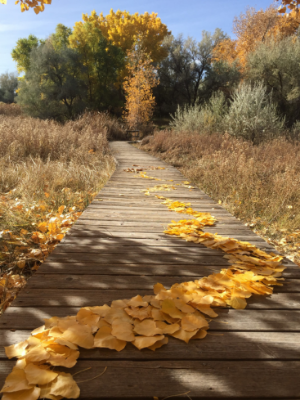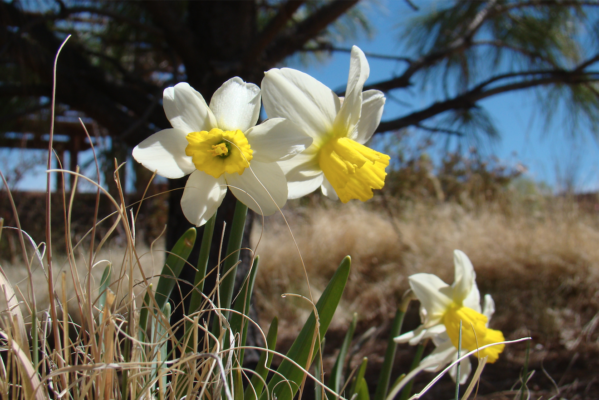October 2019
By Scott Canning, Director of Horticulture and Special Projects
 More certain than my grandmother’s admonition on the Fourth of July that “Summer is OVER!” is October’s chilly mornings, the disappearance of hummingbirds, the evening chorus of crickets replacing cicadas, and the Big Tesuque turning gold. Autumn is here.
More certain than my grandmother’s admonition on the Fourth of July that “Summer is OVER!” is October’s chilly mornings, the disappearance of hummingbirds, the evening chorus of crickets replacing cicadas, and the Big Tesuque turning gold. Autumn is here.
I love the fall for almost everything it brings, but for the growing darkness. We lose minutes of light every day. I take comfort in the bulb catalogs that arrived back in late August and September. Bulbs are such a gift; they are little bundles of hope we tuck in the soil and pray to see come spring.
I spent many years growing thousands of bulbs at the Brooklyn Botanic Garden. We planted great masses of hardy bulbs in outdoor beds; we “forced” hardy bulbs to bloom out-of-season for our glasshouse displays (“forcing” is using artificial growing techniques to trick bulbs into blooming very early), and I grew hundreds of species of tender bulbs that mostly hailed from Mediterranean climates. These tender bulbs we didn’t force; instead we replicated South Africa, Chile, the Mediterranean lands and coastal California climates under glass, with a regimen of cool but not freezing temperatures and winter moisture, as you would find in these places. Think of paperwhite narcissi, whose wild ancestors hailed from the Mediterranean: they want to grow in winter, no forcing, and then bloom in late winter and earliest spring.
I bring up the connection between bulbs and climate because it can be so instructive on how best to choose and grow bulbs in Santa Fe gardens. We are in a cold-continental or steppe region, and we should look to bulbs from those regions with the expectation that they might be best-suited to our gardens. And that has been my experience.
Many wild tulips hail from Asia Minor and the area once known as Persia. This is an area, like California, of primarily summer drought. Importantly, tulips often rot when exposed to summer wetness and are best planted in areas without summer irrigation, an important clue to success. One notable wild tulip is Tulipa greigii, a species that is the parent of a whole class of tulips, the “Greigii” tulips. These are early-blooming, somewhat short in stature, and usually sport wonderfully mottled foliage. They mostly are reds, pinks and combinations of those colors with white striping. ‘Red Riding Hood’ is a classic, and a creamy yellow breakthrough is called simply ‘Vanilla Cream’. Lots of garden selections have been made from Tulipa batalinii: ‘Bright Gem’ is apricot, ‘Honky Tonk’ is yellow, and self-explanatory are ‘Bronze Charm’, ‘Salmon Gem’, and ‘Red Gem’. Another species that has yielded lots of garden varieties is Tulipa clusiana: ‘Lady Jane’ is a pale peppermint stick, ‘Peppermint Stick’ is bolder, ‘Cynthia’ is a red and yellow two-tone, and T. clusiana var. chrysantha is a bold ‘Cynthia’. Other species tulips to try are Tulipa turkestanica (white with a yellow eye), Tulipa daystemon (yellow with white tips), and Tulipa tarda (mostly yellow with the smallest of white tips).
For those determined to grow large garden tulips, the most successful here are the “Single Early” selections like ‘Apricot Beauty’. Next best choices are the Darwin and Triumph types, which tend to bloom early and have the best perennial traits (lasting more than a year or two). There are hundreds of these to choose from. You can find these “groups,” or classes of tulips broken out into Species, Greigii, Single Early, Triumph, Darwin, etc., in the listings of the better tulip dealers. I hesitate to recommend any in particular, but this scheme of “classes” of tulips is followed by both John Scheeper’s and Brent & Becky’s Bulbs, and they provide photos. Van Engelen is the wholesale arm of Scheeper’s – they include no photographs in their paper catalog but better pricing on large quantities. I depend on such sources for quality, and bulbs that are true to name.

Photo by Clayton Bass
The narcissus, our “daffodils,” are native to the Mediterranean climate area, by and large; primarily from Spain and Morocco eastward to the Caucasus Mountains. They often require more moisture than the species tulips when in active growth. Importantly, dormant species tulips survive hot, dry summer soil better than narcissus, which can desiccate without some supplemental water in summer. An area under deciduous trees or a sunlit but north-facing slope are more amenable to growing narcissus than sun-blasted locations.
Once again, the lower-growing varieties are the least water-intensive. We “naturalized” ‘Jack Snipe’ in our grassy, revegetation mix on a slightly north-facing slope beside our main path and it is performing well without supplemental water. Others to try include ‘Tete-a-tete’, ‘Hawera’, ‘Kokopelli’, ‘Sun Disc’, ‘Minnow’ and ‘Xit.’
There are many alliums that perform well in Santa Fe. Our native nodding onion, Allium cernuum, is native to most of the United States, so is highly adaptable to extremes of temperature and moisture. It is found locally in woodlands in the Sangre de Cristo foothills and throughout the Pecos drainage. The bulb is slender and somewhat fragile, so it is best purchased as a potted plant at a nursery. Other alliums to consider are species like Allium caesium. It is native to Central Asia and has foot-high 2 1/2-inch flowers clusters of the palest sky-blue. Allium christophii, known as the “star of Persia,” is a foot or more tall with striking, spreading metallic violet florets. Allium schubertii is stunning at 16 inches tall; fully half of the height is a fireworks-like floral display that ripens to a round tumbleweed seed head that rolls across the landscape in its native Middle Eastern and North African habitats. Allium moly is native to south and southwest Europe and the cultivated form ‘Jeanine’ is bright golden-yellow. Allium nigrum is a Middle Eastern native with white, “muffin top” flower heads with prominent green, pea-like ovaries. Finally, Allium unifolium is an American West Coast native adapted to summer dormancy/drought. Wild forms are usually white, but most forms commercially available are a light, dusty pink. I mention and recommend these particular species alliums and other uncommon garden bulbs only when they are commercially available with little difficulty, so be a bit experimental and don’t despair!
I’m exhausted, aren’t you? And that is just three genera of bulbous plants worth trying in Santa Fe. A quick survey of just two more: Eremerus, the foxtail lilies, are grown at the Denver Botanic Gardens to marvelous effect. The delicate, octopus-like bulbs are extremely fragile and should be planted shallowly and with great care so as not to sever a brittle “arm.” The flower stems are very tall and narrow and a little top-heavy in bloom, therefore a location somewhat sheltered from wind is preferable, if you can find that in Santa Fe! They are narrowly pyramidal towers of flowers and very showy. The strongest perennial is Eremerus himalaicus and is snowy-white and will increase by offsets. More popular are the hybrids in yellow, pink, and orange. Most commonly available and one of the showiest orange hybrids is named ‘Cleopatra.’
Finally, the fritillaries. Fritillaria is a genus of plants related to the lilies with a similar bulb structure. Most garden types hail from the Mediterranean, through the Middle East into Western Asia. They are variable in size, but have mostly singular, bell-shaped pendant flowers. There are many kinds here, but once again, some of the smaller types work best in a steppe climate like ours. Fritillaria meleagris is the “checkered lily” or “snake’s head lily” and is maroon, sometimes white, and has wonderfully patterned flowers. Another to try is F. uva-vulpis. With maroon bells edged in yellow-orange, it is less than 10 inches tall, like the previous species. The species name translates as “wolf’s egg.” How cool and weird is that? I hope you will experiment with some of these off-beat, less-common bulbs that suit our climate, because they can be so rewarding. Happy bulb shopping!
Purchase your bulbs from Brent and Becky’s Bulbs, and a portion of the purchase will support the Santa Fe Botanical Garden!


